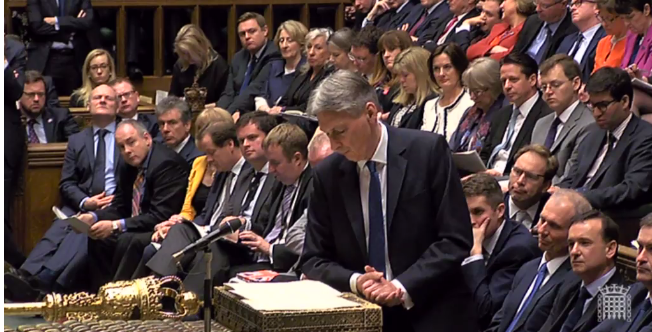With any luck someone will say 'Spring in the air!" and Hammond will. Apart from that though ....
The Spring Statement is also known as a "mini-budget", it'll contain
- updated economic and public finance forecasts
- ideas on possible tax reforms
The statement will take the form of a speech, lasting about 20 minutes
What to watch for? Previews via ...
Barclays:
Following the Chancellor's announcement at the Autumn Statement 2016, there will now only be one major fiscal event each year held in Autumn. Budget execution is well ahead of targets two months before the end of FY 2017, as January delivered a solid surplus of £10bn on healthy self-assessment revenues. The use of such extra headroom, if maintained, will be addressed at the Autumn Budget, while the Spring Statement
- is unlikely to include policy measures but merely present an update of the macroeconomic assumptions
- GDP and productivity growth have been stronger than expected in the OBR's November projections suggesting the potential for an upgrade in near-term outlook; however, the longer-term forecasts are unlikely to be revised much.
Credit Suisse:
The Spring Statement is unlikely to contain any tax and spending policy announcements, which are now reserved for the autumn budget. But it is likely to reveal an improvement in public finances worth as much as £9bn in 2017/18.
- This is due to an increase in self-assessed tax receipts as well as a pickup in productivity
- Productivity growth in 2017 has come in at 0.6%, compared with the zero growth expected by the OBR back in November.
- We expect PSNB-ex forecast for 2017/18 to be revised down from £49.9bn In the November budget to £41bn.
- The UK also is running a current budget surplus for the first time since 2002. This should imply a bigger margin against the Chancellor's fiscal rule. It should come in at around £30bn at the end of the forecast period, up from the projected £15bn in November.
- The growth forecasts are also likely to be revised up given the better than expected growth data. The OBR will also estimate the impact of the Brexit divorce payments on the public finances for the first time in an annex. The OBR will present a chart of what payments the UK will make every year, stretching well into the future.
RBC:
- The much slimmed-down spring fiscal event won't contain any new policies, so it is set to result in a parliamentary address of just fifteen minutes or so by the Chancellor.
- Nevertheless, the OBR's updated economic and fiscal forecasts will be as detailed as ever and could see the cumulative government borrowing forecast out to 2022-23 fall by £46bn to £166bn as the OBR acknowledge a slightly better than expected economic backdrop.
- For the Gilt market, the focus will be on the DMO's new Gilt sales remit for 2018-19. Our expectation is that gross Gilt issuance could drop to £98bn, which would be the first sub-£100bn total since 2007-08.
(bolding mine)




